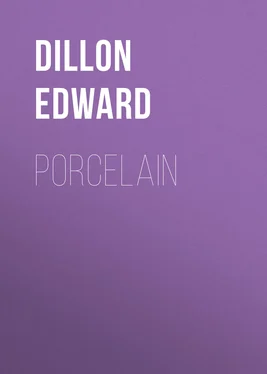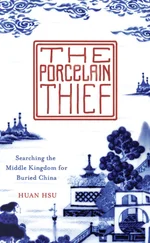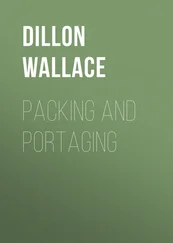Edward Dillon - Porcelain
Здесь есть возможность читать онлайн «Edward Dillon - Porcelain» — ознакомительный отрывок электронной книги совершенно бесплатно, а после прочтения отрывка купить полную версию. В некоторых случаях можно слушать аудио, скачать через торрент в формате fb2 и присутствует краткое содержание. Жанр: foreign_prose, foreign_antique, на английском языке. Описание произведения, (предисловие) а так же отзывы посетителей доступны на портале библиотеки ЛибКат.
- Название:Porcelain
- Автор:
- Жанр:
- Год:неизвестен
- ISBN:нет данных
- Рейтинг книги:4 / 5. Голосов: 1
-
Избранное:Добавить в избранное
- Отзывы:
-
Ваша оценка:
- 80
- 1
- 2
- 3
- 4
- 5
Porcelain: краткое содержание, описание и аннотация
Предлагаем к чтению аннотацию, описание, краткое содержание или предисловие (зависит от того, что написал сам автор книги «Porcelain»). Если вы не нашли необходимую информацию о книге — напишите в комментариях, мы постараемся отыскать её.
Porcelain — читать онлайн ознакомительный отрывок
Ниже представлен текст книги, разбитый по страницам. Система сохранения места последней прочитанной страницы, позволяет с удобством читать онлайн бесплатно книгу «Porcelain», без необходимости каждый раз заново искать на чём Вы остановились. Поставьте закладку, и сможете в любой момент перейти на страницу, на которой закончили чтение.
Интервал:
Закладка:
This is all that scientific research has so far been able to tell us of the intimate constitution of porcelain; but as far as it goes, it is evidence in favour of our claim that we are dealing with a definite substance, sui generis , and not merely with a casual mixture of certain superior kinds of clay, something, as we have said, between glass and stoneware.
There are certain other elements that enter at times into the composition of porcelain—magnesia, which may have been added to the paste in the form either of steatite or magnesite; and lime, derived either from gypsum or chalk. These additions generally tend to increase the fusibility of the paste, especially when accompanied by an additional dose of silica; but as their presence is not essential we are not concerned with these substances here.
The glazes used for porcelain are as a rule distinguished by their comparative infusibility and by their containing no lead. The composition of these glazes follows more or less that of the paste that they cover, with such modifications, however, as to allow of a somewhat lower fusing-point: as in the case of the paste, there is a harder and more refractory, and a softer and more fusible, type. The harder glazes are composed essentially of felspar, with the addition in most cases of silica, kaolin, and powdered fragments of porcelain. At Sèvres, a natural rock, pegmatite, consisting chiefly of felspar, has been melted to form a glaze without further addition. Of late years, however, the introduction of a milder type of porcelain has necessitated the use of a more fusible glaze, containing a considerable quantity of lime, and it is a glaze of this latter type that has with few exceptions found favour in other districts where porcelain is made.
We have attempted in this chapter to give some idea of the nature of porcelain from a physical and chemical point of view, and in doing so have taken as our type the hard, refractory paste of Europe. When we come to describe the porcelain of the Chinese, we shall notice some important divergences from this type. We say nothing here of the soft-paste porcelains, seeing that so long as we confine ourselves to the question of chemical composition and physical properties, they lie entirely outside our definitions. It is only from the point of view of its history and of its artistic qualities that this group has any claim to the name of porcelain.
CHAPTER II
THE MATERIALS: MIXING, FASHIONING, AND FIRING
IT would be quite foreign to the scope and object of this book to attempt to describe in any detail the different processes that come into play in the manufacture of a piece of porcelain. There is the less cause for any such detailed treatment, inasmuch as the operations involved in the preparation of the paste and in the subsequent potting and firing do not essentially differ in the case of porcelain from those employed in the manufacture of other classes of pottery. The differences are rather those of degree—greater care is necessary in the selection of the materials, and these materials must be more finely ground and more intimately mixed. Again, the great heat required in the kilns necessitates, in the firing of porcelain, many precautions that are not called for in the case of earthenware or fayence. Without, however, some slight acquaintance with the processes of the manufacture, it would be impossible to avoid an amateurish and somewhat ‘anecdotal’ treatment of our subject. There are, indeed, many intimate features, many delicate shades of difference that distinguish the wares of various times and places, both in Europe and in the East, which can only be rationally explained by reference to the details of the manufacture.
At the present day there is only one district in Europe where true porcelain is manufactured on a large scale. This district lies on the western and south-western border of the central granitic plateau of France, especially in the Limousin and in Berry. Again at Sèvres, for the last hundred years and more, a succession of able chemists has carried on a series of experiments on the composition and preparation of porcelain. It is no wonder, then, if we find that the literature concerned with these practical departments is almost entirely French. One result of this is a greater richness in technical terms than with us. We find in France names for the various implements and processes of the potter’s art, that are something better than the workshop terms of the local potter. Again, the little that has been written in England upon the technology of pottery has been concerned chiefly with earthenware of Staffordshire. 6 6 It is to the scattered notices and essays of Mr. William Burton that we must go for information in this country. In his new work on English Porcelain he does not treat upon this side of the subject.
As for the English soft-paste porcelain of the eighteenth century, there is a remarkable dearth of information both as to its composition and as to its manufacture. We know in fact in much greater detail how the great potteries at King-te-chen were carried on at the same period, thanks to the letters of the Père D’Entrecolles, and to the information collected in Dr. Bushell’s great work, Oriental Ceramic Art (New York, 1899. I shall always quote from the text edition).
The following technical notes are based chiefly on the processes in use either at Sèvres or in the great factories of the Limoges district. 7 7 The most complete work on the processes of manufacture is now Dubreuil’s La Porcelaine , Paris, 1885. It forms part forty-two in Fremy’s Encyclopédie Chimique . This volume brings up to date and replaces in some measure the great work of Alexandre Brongniart, the Traité des Arts Céramiques (two volumes, with a quarto volume of plates), Paris, 1844. M. Georges Vogt in La Porcelaine , Paris, 1893, gives valuable details of the processes employed at Sèvres.
To begin with the Kaolin, the ‘premier’ element in the composition of porcelain. The greatest care is taken to procure a pure white clay which should approach as near as possible to the more or less theoretical mineral kaolinite, i.e. to a hydrous silicate of alumina. With this object the rough china-clay brought from the pit is thrown into a large tank of water and broken up with wooden spades; the milky liquid is now decanted into a second tank, leaving behind most of the quartz and the other stony particles. On its way the soup-like liquid passes through the meshes of a sieve—these may be formed either of brass wire or sometimes of finely woven silk. On this sieve all but the finest particles are retained. The greater part of the kaolin is deposited in this second tank, but a certain portion still remains suspended in the liquid, which is again decanted; the remaining kaolin then settles down in the third tank, yielding the finest clay. To dry this slimy mass, it is first forced by hydraulic pumps into canvas bags, and these bags are then pressed between fluted wooden trays, strongly clamped together. We have now got a white chalky mass which may contain as much as 98 per cent. of the hydrated silicate of alumina.
The other materials, the china-stone 8 8 The cailloux of the French. This material is often described as felspar, but I think that quartz can seldom be completely absent.
and the quartz, have first to be reduced to the finest powder. To effect this they may, to begin with, be roasted to effect disintegration, then crushed in a stone-breaking machine, and finally passed through the grinding-pan in which they are ground fine between large blocks of chert which rotate upon a pavement of the same stone. The finely ground materials have now to be mixed in suitable proportions either by the old process of ‘slop-blending,’ where the different ‘slops,’ each of known specific gravity, are run in due proportion into the big ‘blending ark,’ or, as is now usual in the case of fine wares, by weighing out the materials in a dry state. On the relative amounts of the three elements, the china-clay, the china-stone, and the quartz, the nature of the porcelain after firing will depend. M. Vogt ( La Porcelaine , Paris, 1893) gives a useful table showing the limits within which the materials may be varied. We may note that in the case of a normal china-stone or petuntse being used instead of felspar, very little additional quartz is required. These limits are: kaolin, 35 to 65 per cent.; felspar, 20 to 40 per cent.; and quartz, 15 to 25 per cent. The larger the percentage of the first material, the harder and more refractory will be the resultant porcelain.
Интервал:
Закладка:
Похожие книги на «Porcelain»
Представляем Вашему вниманию похожие книги на «Porcelain» списком для выбора. Мы отобрали схожую по названию и смыслу литературу в надежде предоставить читателям больше вариантов отыскать новые, интересные, ещё непрочитанные произведения.
Обсуждение, отзывы о книге «Porcelain» и просто собственные мнения читателей. Оставьте ваши комментарии, напишите, что Вы думаете о произведении, его смысле или главных героях. Укажите что конкретно понравилось, а что нет, и почему Вы так считаете.












